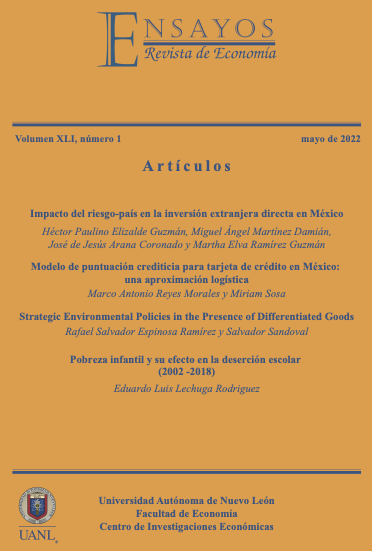Modelo de puntuación crediticia para tarjeta de crédito en México: una aproximación logística
Credit Scoring Model for Credit Card in Mexico: A Logit Approach
DOI:
https://doi.org/10.29105/ensayos41.1-2Palabras clave:
puntuación crediticia; tarjeta de crédito; México; modelo logísticoResumen
El riesgo de crédito es una de las principales preocupaciones de los organismos de supervisión y regulación financiera, así como de las instituciones bancarias. Así, se propone un modelo de puntuación crediticia basado en una regresión logística, para analizar la probabilidad de incumplimiento por segmentos de una cartera de clientes de tarjeta de crédito de una institución mexicana. Los resultados muestran que el modelo propuesto tiene un alto nivel de predictibilidad y de estabilidad, tanto fuera como dentro del periodo de modelado, la comprobación de monotonicidad, también asegura que el modelo tenga un alto nivel de precisión. La originalidad subyace en que existen escasos estudios sobre modelos de puntuación crediticia para México, el resultado del modelo tiene alto nivel de precisión y arroja como resultado una tabla de puntuación de fácil interpretación para el personal bancario. Se concluye que el modelo es confiable y con alto nivel de ajuste.
Descargas
Citas
Alaka, H. A., Oyedele, L. O., Owolabi, H. A., Kumar, V., Ajayi, S. O., Akinade, O. O., & Bilal, M. (2018). Systematic review of bankruptcy prediction models: Towards a framework for tool selection. Expert Systems with Applications, 94, 164-184. DOI: https://doi.org/10.1016/j.eswa.2017.10.040
Ampountolas, A., Nyarko Nde, T., & Constantinescu, C. (2021). A Machine Learning Approach for Micro-Credit Scoring. Risks, 9(3), 50. DOI: https://doi.org/10.3390/risks9030050
Ansari, A., Ahmad, I. S., Bakar, A. A., & Yaakub, M. R. (2020). A hybrid metaheuristic method in training artificial neural network for bankruptcy prediction. IEEE Access, 8, 176640-176650. DOI: https://doi.org/10.1109/ACCESS.2020.3026529
Byström, H. (2019). Blockchains, real-time accounting, and the future of credit risk modeling. Ledger, 4. DOI: https://doi.org/10.5195/ledger.2019.100
Caruso, G., Gattone, S. A., Fortuna, F., & Di Battista, T. (2021). Cluster Analysis for mixed data: An application to credit risk evaluation. Socio-Economic Planning Sciences, 73, 100850. DOI: https://doi.org/10.1016/j.seps.2020.100850
Chuang, C. L., & Lin, R. H. (2009). Constructing a reassigning credit scoring model. Expert Systems with Applications, 36(2), 1685-1694. DOI: https://doi.org/10.1016/j.eswa.2007.11.067
Devi, S. S., & Radhika, Y. (2018). A survey on machine learning and statistical techniques in bankruptcy prediction. International Journal of Machine Learning and Computing, 8(2), 133-139. DOI: https://doi.org/10.18178/ijmlc.2018.8.2.676
Ignatius, J., Hatami-Marbini, A., Rahman, A., Dhamotharan, L., & Khoshnevis, P. (2018). A fuzzy decision support system for credit scoring. Neural Computing and Applications, 29(10), 921-937. DOI: https://doi.org/10.1007/s00521-016-2592-1
Medina-Olivares, V., Calabrese, R., Dong, Y., & Shi, B. (2021). Spatial dependence in microfinance credit default. International Journal of Forecasting. DOI: https://doi.org/10.1016/j.ijforecast.2021.05.009
Papouskova, M., & Hajek, P. (2019). Two-stage consumer credit risk modelling using heterogeneous ensemble learning. Decision support systems, 118, 33-45. DOI: https://doi.org/10.1016/j.dss.2019.01.002
Puertas Medina, R. M., & Martí Selva, M. L. (2013). Análisis del credit scoring. RAE-Revista de Administração de Empresas, 53(3), 303-315. DOI: https://doi.org/10.1590/S0034-75902013000300007
Siddiqi, N. (2017). Intelligent credit scoring: Building and implementing better credit risk scorecards. John Wiley & Sons. DOI: https://doi.org/10.1002/9781119282396
Torvekar, N., & Game, P. S. (2019). Predictive analysis of credit score for credit card defaulters. Int. J. Recent Technol. Eng, 7(1), 4.
Trejo-García, J. C., Ríos-Bolívar, H., & Martínez-García, M. Á. (2016). Análisis de la administración del riesgo crediticio en México para tarjetas de crédito. Revista mexicana de economía y finanzas, 11(1), 103-121. DOI: https://doi.org/10.21919/remef.v11i1.79
Vega Mena, M. D. L., Santoyo Cortés, V. H., Muñoz Rodríguez, M., & Altamirano Cárdenas, J. R. (2017). Reducción de costos de transacción e información asimétrica: experiencias de financiamiento rural en México. Estudios sociales (Hermosillo, Son.), 27(49), 181-209.
Zhang, Y., Liu, R., Heidari, A. A., Wang, X., Chen, Y., Wang, M., & Chen, H. (2021). Towards augmented kernel extreme learning models for bankruptcy prediction: algorithmic behavior and comprehensive analysis. Neurocomputing, 430, 185-212. DOI: https://doi.org/10.1016/j.neucom.2020.10.038
Archivos adicionales
Publicado
Cómo citar
Número
Sección
Licencia
Derechos de autor 2022 Marco Antonio Reyes Morales, Miriam Sosa

Esta obra está bajo una licencia internacional Creative Commons Atribución 4.0.
















